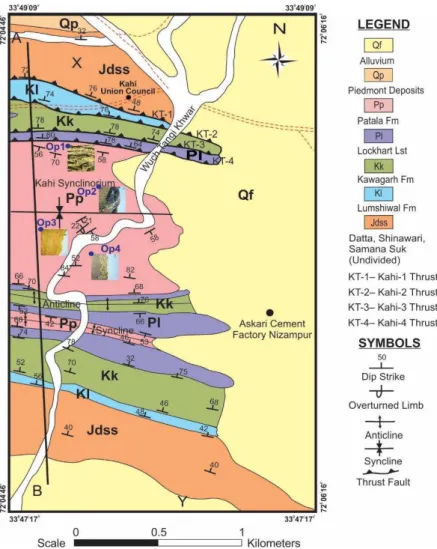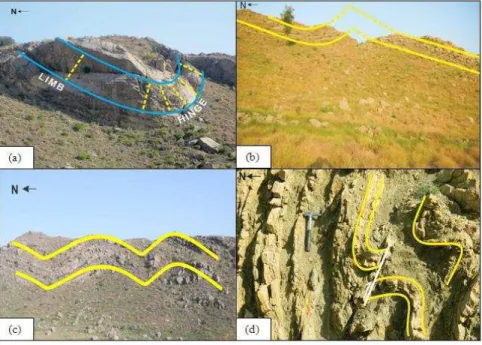Int. j. econ. environ. geol. Vol:7(2)80-84, 2016
www.econ-environ-geol.org
Short Communication
Mesoscopic Structures can give Insights to the Regional Ones
–
An Example of
Pumpelly’s Rule from a part of
Kala-Chitta Range near Kahi Village,
Nizampur, Khyber Pakhtunkhwa, Pakistan: An Insight into Economic Geology
Muhammad Awais
1, Muhammad Ishaq
1, Naveed Akhtar
2,
Muhammad Haroon
3, Suleman Khan
41
Department of Geology, University of Swabi, Pakistan.
2
National Centre of Excellence in Geology, University of Peshawar, Pakistan.
3
G3 Engineering Consultants (Pvt) Ltd., Lahore, Punjab, Pakistan.
4
Department of Geology, University of Peshawar, Pakistan.
*Email:
awais.geo@uoswabi.edu.pk
Introduction
The Himalayan mountain belt is comprised of southward-propagating thrust sheets that formed soon after the collision of Indian and Eurasian plates in Eocene. The Pakistani Himalayan Thrust System from hinterland in the north to foreland in the south consists of Main Karakoram Thrust (MKT), Main Mantle Thrust (MMT), Main Boundary Thrust (MBT) and Salt Range Thrust (SRT) (Treloar, 1989; Kazmi and Rana, 1982). In Pakistani Himalayas, the general trend of the major structures (thrusts) is east-west (Nakata and Kumhara, 2002) (Fig. 1).
The hill ranges are part of northwestern Himalayan fold-and-thrust belt, which consist of Attock Cherat Range (ACR), Kala-Chitta Range, Gandghar Range, Kherimar Hills and Margalla Hills (Hylland, 1990). The ACR has three fault-bounded structural blocks. The Khairabad Thrust serves as a boundary between Precambrian rocks, thrust over the Silurian-Devonian sequence of ACR along the Cherat Fault (Yeats and Husain, 1987). The uplifting of the hill ranges is associated with the south-directed thrusting. The hill ranges fault system forms a hinterland-dipping duplex (Yeats and Husain, 1987; Hylland, 1990). The fault system includes MBT, Murree, Nathia Gali, Cherat, Hissartang, Khairabad, Panjal and Baghdarra faults
Open Access
(Hylland, 1990) (Fig. 2).
The Kala-Chitta Range is a part of the hill ranges of Northern Pakistan (Yeats and Lawrence, 1984). It occurs to the north of the Southern Deformed Fold and Thrust Belt (SDFTB) and to the south of ACR separated by Hissartang Thrust. Moreover, it is in lateral continuity with the Maragalla Hills towards east and Samana Range to the west (Fig.1). The Kala-Chitta Range and Kohat-Potwar Plateau are separated by MBT towards the south of Kahi area (McDougall and Hussain, 1991). The Kahi area shows complex structural pattern and the general trend of the structures in the area is east-west (Yeats and Hussain, 1987).
Structural analysis depicts the structural history of an area, the geometry and orientation of the major structures from investigation of the styles and associations of small-scale structures (Price and Cosgrove, 1990). According to Wilson (1961, 1982), small-scale structures (minor structures) are those structures of tectonic origin that can be observed with the naked eye in the field. The scale varies from hand-specimen to outcrop or even mountain belt. Identification and interpretation of minor structures assist the field geologist to demarcate the regional geological structures of that specific area. For example, minor structures indicate the order of stratigraphic sequence in beds devoid of fossils and also reflect clues of progressive stages in the tectonic history (Price and Cosgrove, 1990). Raphael Pumpelly (1894) devised a rule called as Pumpelly’s Rule, defined as the axes and the axial surfaces of the minor folds of an area are congruent with those of the major fold structures of the same phase of deformation. It implies
that the orientation of small-scale structures portrays that of the regional structures.
Discussion
The Kahi area of the Kala-Chitta Range is intensely deformed implying the complicated history that is typical of fold-and-thrust belt. Mesoscopic scale structure of the area gives an analogue image of the regional structures and tectonics of the ACR and North Pakistan. The four thrust faults i.e. Kahi-1 Thrust (KT-1), Kahi-2 Thrust (KT-2), Kahi-3 Thrust (KT-3) and Kahi-4 Thrust (KT-4) are demarcated based on the stratigraphic overlay of older geological formations over younger ones (Awais et al., 2012, 2013) (Figs. 3, 4a).
The vergence of thrust faults encountered in the Kahi area is southward in the direction of regional tectonic transport direction from north to south. It is identical to the south-verging thrust faults of ACR. Similarly, the regional faults i.e. MKT, MMT, MBT and SRT of northern Pakistan also have southward vergence corresponding in vergence to the indigenous thrust faults of the Kahi area. The Kahi area thrust faults have east-west orientation like that of the east-west oriented thrust faults of ACR (Figs. 1,3, 4a,b). Almost all the regional faults (MKT, MMT, MBT and SRT) are also oriented in east-west direction. In addition, the mesoscopic fault cutting s-shaped drag folds also has southward vergence (Fig. 5a). The geological map of the Kahi area and regional tectonic map of Northern Pakistan are compared (Figs. 1, 3). Similarly, Kahi area and regional structural cross-sections are also compared giving very pertinent geological details
Int. j. econ. environ. geol. Vol:7(2)80-84, 2016
www.econ-environ-geol.org
implying Pumpelly’s rule (Figs. 4a,b). The concentric parallel folds, antiform and synform axes are parallel to the axis of regional Kahi Synclinorium in Kahi area, Kala-Chitta Range (Fig. 5b,d). The axes of folds striking in the east-west direction confirming the north-south compression stresses akin to that of the regional compression stresses between the Indian and Eurasian plates (Figs. 3, 4a).
The correlation between east-west trending regional faults of the Himalayas (Northern Pakistan), ACR and local faults of the Kahi area, Kala-Chitta Range are given in Table 1. The faults vergence, orientation and fold axis have strong coincidence between the local and regional tectonic set up. Therefore, it follows Pumpelly’s rule disclosing about regional geological features using local small-scale structural geometric features.
Fig. 4 Cross-sections correlation: (a) cross-section along line A-B on geological map of a part of Kala-Chitta Range, Kahi Village (Awais et al., 2012 and 2013) and (b) regional cross-section from the Himalayan MMT to SRT in the Salt Range,
Implications for Economic Geology
Geological structures (folds, fractures, faults and joints) are of vital importance in economic geology such as petroleum geology, ore geology, mineral resources and mining geology (Russell, 1955). The economic deposits (minerals and hydrocarbons) are most often associated with geological structures such as in Pakistan they might be associated with MKT, MMT, MBT, SRT, KT-1, KT-2, KT-3 and KT-4 respectively. Folded and faulted rocks develop into
traps that can hold and transmit fluids like petroleum and natural gas. Likewise, fractured and faulted zones are vacant spaces and can serve as permeable zones, thereby facilitating the fluids (hydrothermal) to pass through them precipitating base and precious metal ore deposits. The mineral veins having economic metals usually occupy faults and fractures in deformed terrains. The deposits of gold, silver, copper, lead and zinc etc. are generally present in the structurally complicated areas.
Fig. 5 Outcrop pictures showing east-west orientation similar to the orientation of regional structures: (a) Concentric parallel synform (Awais et al., 2012 and 2013); (b) antiform, (c) antiforms and synforms and (d) mesocopic fault with southward vergence.
Int. j. econ. environ. geol. Vol:7(2)80-84, 2016
www.econ-environ-geol.org
In the vicinity of MKT, the Karakoram block contains polymetallic sulphides (Cu, Pb, Sb, As, Zn) with gold, silver and scheelite deposits along faults and mostly as fissure fillings (Kazmi and Jan, 1997). The minerals associated with MMT includes hydrothermal graphite, galena, antimony, magnetite, uranium, beryl, copper (chalcopyrite, azurite, chalcocite, malachite), hematite, barite, scheelite, ilmenite, tentalite, columbite, pyrite, nickel, manganese, emerald, rare earths, fluorite, sphalerite, chromite molybdenite, pitchblende, bornite, magnesite and asbestos etc (Tahirkheli, 1979). The MBT, SRT and Hill ranges being part of Foreland fold and thrust belt consisting of sedimentary, non-metallic mineral deposits and hydrocarbons (Kazmi and Jan, 1997).
Conclusions
Four thrust faults of the Kahi area, Kala-Chitta Range have southward vergence similar to thrust faults of ACR and Northern Pakistan reflecting Pumpelly’s rule.
Geological structures (folds and faults) of the Kahi area, Kala-Chitta Range are east-west oriented similar to thrust faults of ACR and Northern Pakistan demonstrating Pumpelly’s rule.
In Pakistan, the tectonic/geological structures (MKT, MMT, MBT, SRT, KT-1, KT-2, KT-3 and KT-4) are of vital importance for economic geology.
Acknowledgements
Mr. Nowrad Ali, Lecturer, Department of Geology, University of Peshawar, Pakistan is thanked for critical review of this article.
References
Awais, M. Akhtar, N. Ishaq, M. (2012 and 2013). Geological mapping and structural analysis of a part of Kala-Chitta Range, Kahi Village, Nizampur, Khyber Pakhtunkhwa. Pak. Jour. Hydrocarb. Res., 22 and 23, 13-23.
DiPietro J. A., Pogue, K. R. (2004). Tectono- stratigraphic subdivisions of the Himalaya: A view from the west. Tectonics, 23. DOI: 10.1029/ 2003 TC001564
Hylland, M. D. (1990). Geology of the southern Gandghar Range and Kherimar Hills, Northern Pakistan. M.S. Thesis, Oregon State University, (USA).
Kazmi, A. H., Jan, M. Q. (1997). Geology and Tectonics of Pakistan. Graphic Publishers, Karachi, Pakistan, 554p.
Kazmi, A. H., Rana, R. A. (1982). Tectonic map of Pakistan at a scale of 1:200,000. Geological Survey of Pakistan, Quetta.
McDougall, J. W., Hussain, A. (1991). Fold and Thrust Propagation in the Western Himalaya based on a balanced cross section of the Surghar Range and Kohat Plateau, Pakistan. Am. Assoc. Petrol. Geol. Bull., 75(3), 463-478.
Nakata, T., Kumhara, Y. (2002). Active faulting in and around Himalaya and its significance in the collision tectonics. Act. Fault Res., 22, 7-16.
Price, N. J., Cosgrove, J. W. (1990). Analysis of Geological Structures. Cambridge University Press, Cambridge, England. 459p,
Russell, W. L. (1955). Structural Geology for Petroleum Geologists. New York, McGraw-Hill, New York, USA, 1p.
Tahirkheli, R. A. K. (1979). The Main Mantle Thrust: Its Score in Metallogeny of Northern Pakistan. Geol. Bull Univ. Peshawar (Currently J. of Himalaya Earth Sci.), 13, 193-198.
Treloar, P. J. (1989). Imbrication and unroofing of the Himalayan thrust stack of the north Indian plate, north Pakistan. Geol. Bull. Univ. Peshawar, 22, 25-44.
Wilson, G., (1961). The tectonic significance of small-scale structures and their importance to the geologist in the field. Annales de la Société Géologique de Belgique, 84, 424-548.
Wilson, G. (1982). Introduction to small-scale geologic structures. George Allen & Unwin Ltd., London, 128p.
Yeats, R. S., Hussain, A. (1987). Timing of structural events in the Himalayan foot hills of NW Pakistan. Geol. Soc. Am. Bull., 99, 161-176.

